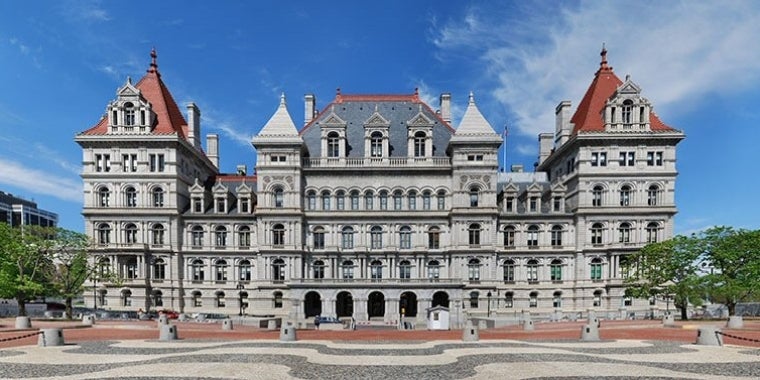
DEP Completes Key Phase in Odor Control Upgrade
Martin J. Golden
May 27, 2010
DEP Completes Key Phase in Odor Control Upgrade
At Owls Head Wastewater Treatment Plant
Activated Carbon Filters Will Help Reduce Odors in Neighborhood
Environmental Protection Commissioner Cas Holloway today announced the completion of a key phase in the odor control upgrade at Owls Head Wastewater Treatment Plant in Brooklyn. Workers completed the installation of two activated carbon filters, which will reduce hydrogen sulfide — the primary odor compound in sewage and the most dominant odor emitted from wastewater treatment plants — by 90 percent from 2006 levels, before odor control upgrades were initiated. With the carbon filters coming online today and with the expected completion of the Residuals Handling Building this December, DEP expects that odors will be substantially eliminated as a community concern. Commissioner Holloway was joined by State Senator Martin Golden and City Council Member Vincent Gentile to activate the new $400,000 carbon filters.
“Treating more than 1.3 billion gallons of wastewater each day is crucial work,” said Commissioner Holloway. “This work is often done near residential areas, and DEP is taking every reasonable measure to limit our impact on the community. Odor conditions at the Owls Head Wastewater Treatment Plant have already improved due to the investments we’ve made since Mayor Bloomberg committed to reducing odors at this plant in 2006 and today’s activation of these carbon filters, along with the state-of-the-art residuals building we will complete by the end of the year, are just the latest steps that DEP is taking to be a better neighbor — and at the same time ensure that New York City’s wastewater is properly treated.”
“I thank Mayor Bloomberg and Commissioner Holloway, and the staff of the Department of Environmental Protection, who have remained committed to improving the quality of life in and around the Bay Ridge area near the Owls Head Wastewater Treatment Plant,” said State Senator Martin Golden. “I am confident that the extensive upgrades will provide much needed relief from the bad odors that we have been experiencing. For those in their backyards or pools, those fishing on the American Veterans Memorial Pier, or those walking along Shore Road enjoying our parkland, this day has not arrived a moment too soon.”
“For far too long the residents of this community have had to endure the horrific odors emanating from this plant,” said Assemblywoman Janele Hyer-Spencer. “I have worked with the community to address this problem and am glad Commissioner Holloway and DEP are taking the necessary steps to control the odors from Owls Head plant. I am hopeful that once all of the proposed work is completed by the end of the year, our community will all be able to breathe easy again.”
“The odor coming from Owls Head has been a thorn in the neighborhood’s side for many years, but under Commissioner Holloway some real action to fix the problem has begun,” City Council Member Vincent Gentile said. “The simple push of a button to activate the plant’s new carbon filters is a giant step toward controlling the odor. This summer is going to be the best one residents along this stretch of Shore Road have had in a few years.”
The carbon filters are 280-cubic-foot canisters that take odorous air from the primary settling tank area and treat it with carbon, which absorbs the odors. Each of the two filters holds 2,300 pounds of carbon and is equipped with a fan that draws 2,000 cubic feet per minute of air through the carbon. DEP determined that the majority of odors were coming from the end of the primary settling process, which is the first stop for wastewater that flows into the plant after it has passed through bar screens to remove debris. The carbon filters remove most of the odors that can be present at this stage in the treatment process.
Hydrogen sulfide is a gas that originates from the decomposition of sewage by bacteria that thrive in sewers, wastewater treatment plants and biological solids. The carbon in the filters is designed to absorb hydrogen sulfide molecules. The treated air that is released from the filters will be periodically tested to determine when the carbon is exhausted and must be replaced. The new filters can hold enough carbon to last for several months before replacement is needed. The filters are designed to absorb the air in the primary settling tanks, which previously were not covered and are located at the south end of the plant, nearest to the community.
Since 2006, DEP has taken significant steps to mitigate odors at Owls Head, including:
· Installing temporary plywood covers at a cost of $50,000 on top of open primary launder tanks and installing nine, 55-gallon drums of carbon, which helped reduce odors until a more comprehensive fix could be implemented.
· Enclosing storage of waste containers. Waste containers store odorous grease and grit from the wastewater treatment process and enclosing the containers reduced odors that previously escaped into the air.
· Rehabilitating venting systems on the screening building at a cost of $100,000.
· Installing a new digesting flare at a cost of $200,000. Previously, methane was vented, not burned. Burning it reduces odors.
· Installing sealed aluminum covers, which cost $800,000 to replace the temporary plywood covers. Aluminum covers are more durable and hold up to humid and corrosive conditions of wastewater treatment.
DEP is also constructing a Residuals Handling Building at the Owls Head plant. The building, which is scheduled to be completed this December, will also have an odor control system that uses carbon filters. The overall cost of the building is $40 million.
Since 2002, the City has invested more than $5 billion upgrading wastewater treatment plants plus nearly $1 billion in combined sewer overflow reduction programs to help improve New York City’s harbor water quality.
The Owls Head Wastewater Treatment Plant went into operation in 1952 and is designed to treat 100 million gallons of wastewater a day. New Yorkers produce, and DEP treats, more than 1.3 billion gallons of wastewater every day. The wastewater is collected through 7,400 miles of lateral sewers that flow downhill into large interceptor sewers, which lead directly to the City’s 14 wastewater treatment plants.
DEP manages the City’s water supply, providing more than 1 billion gallons of water each day to more than 9 million residents, including 8 million in New York City. New York City’s water is delivered from a watershed that extends more than 125 miles from the City, and comprises 19 reservoirs, and three controlled lakes.
Share this Article or Press Release
Newsroom
Go to Newsroom2018 Civil Service & Pensions Committee Annual Report
December 27, 2018

Golden to Mayor: Time for police negotiations long overdue.
August 6, 2018

Concepcion "Connie" Ranocchia
May 15, 2018

